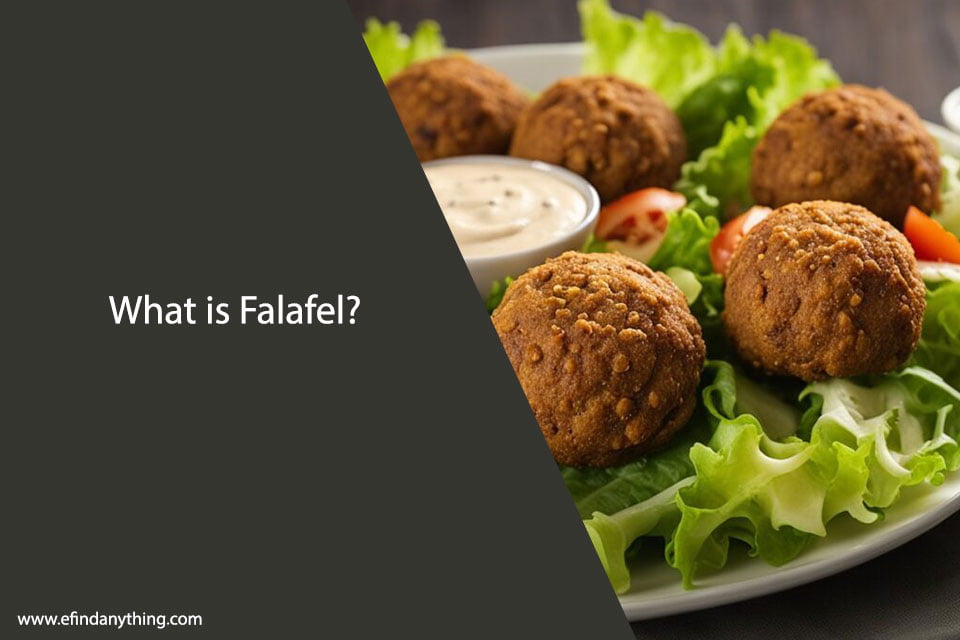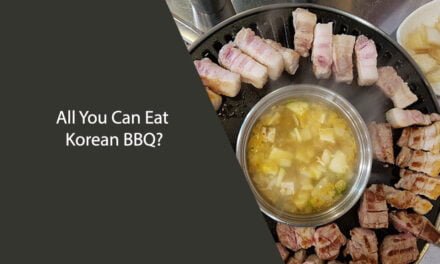Falafel is a popular Middle Eastern dish that has become a favorite around the world. It is a vegetarian food made from ground chickpeas or fava beans, mixed with herbs and spices, then formed into small balls or patties and fried until crispy. Falafel is typically served in a pita bread sandwich with vegetables and a variety of sauces, and it can also be enjoyed as a snack or appetizer.

The origins of falafel are somewhat disputed, with some claiming it originated in Egypt and others in Palestine. Regardless of its origin, falafel has become a beloved food across the Middle East and beyond. It is a versatile dish that can be made with a variety of ingredients and can be customized to suit different tastes and dietary preferences.
Whether you are a long-time fan of falafel or are just discovering this delicious food, there is no denying its popularity and appeal. In this article, we will explore the history of falafel, its ingredients and preparation, and some of the different ways it can be enjoyed. So, sit back and prepare to learn all about this tasty and nutritious food!
Table of Contents
Origins of Falafel
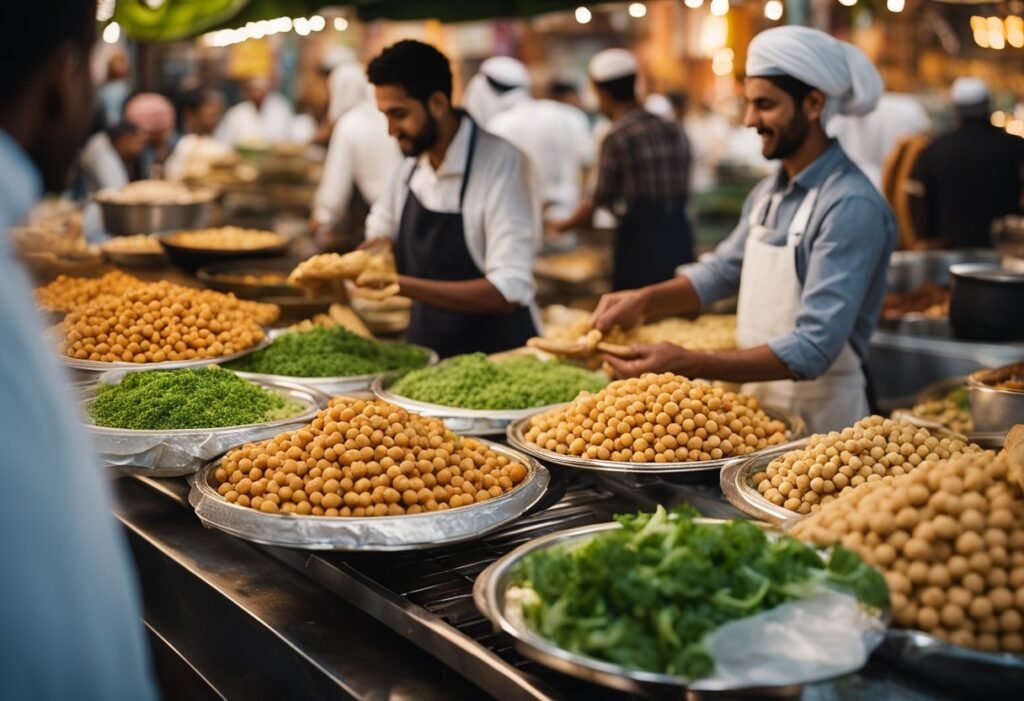
Historical Background
Falafel is a popular Middle Eastern dish made from ground chickpeas or fava beans, mixed with herbs and spices, and then deep-fried. The exact origin of falafel is unclear, but it is believed to have originated in Egypt and then spread to other parts of the Middle East.
The earliest known reference to falafel dates back to the 10th century, where it was mentioned in an Arabic cookbook called “Kitab al-Tabikh” (The Book of Cookery). However, it is likely that the dish existed even before that, as chickpeas have been a staple food in the Middle East for thousands of years.
Geographical Spread
Falafel has since become a popular dish in many countries around the world. It is commonly found in Middle Eastern and Mediterranean cuisine, and is often served as a street food or in fast food restaurants.
In Israel, falafel is considered a national dish and is often served in pita bread with hummus, tahini sauce, and vegetables. In Egypt, falafel is called “ta’amiya” and is often served with a side of salad and bread.
Falafel has also become a popular vegetarian and vegan option, as it is high in protein and can be made without any animal products.
Overall, the origins of falafel may be unclear, but its popularity and delicious taste have made it a beloved dish around the world.
Ingredients of Falafel
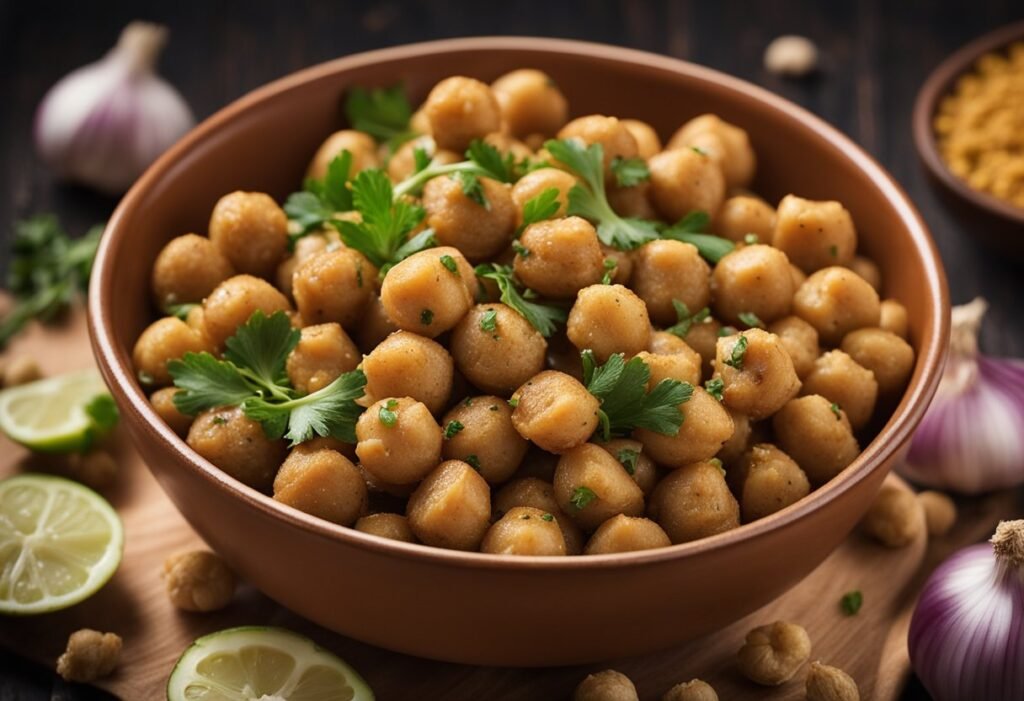
Main Components
Falafel is a popular Middle Eastern dish made from ground chickpeas or fava beans. The main components of falafel include:
- Chickpeas or fava beans: These are the primary ingredients that form the base of falafel. Chickpeas are more commonly used in the Levant region, while fava beans are preferred in Egypt.
- Onion: Finely chopped onions are added to the chickpea or fava bean mixture to enhance the flavor.
- Garlic: Garlic is a key ingredient in falafel that adds a distinct taste and aroma to the dish.
- Flour: A small amount of flour is added to the mixture to bind the ingredients together and form a dough-like consistency.
- Baking powder: Baking powder is added to the mixture to help the falafel balls rise and become fluffy.
Spices and Seasonings
Falafel is seasoned with a variety of spices and seasonings to give it a unique flavor profile. Some of the common spices and seasonings used in falafel include:
- Cumin: Cumin is a spice that adds a warm, earthy flavor to the dish.
- Coriander: Coriander is a herb that is commonly used in Middle Eastern cuisine. It adds a fresh, citrusy flavor to the falafel.
- Parsley: Fresh parsley is added to the mixture to add a bright, herby flavor to the falafel.
- Salt: Salt is added to the mixture to enhance the overall flavor of the dish.
- Pepper: Black pepper is added to the mixture to add a slight heat and depth of flavor to the falafel.
Overall, the combination of these ingredients creates a delicious and nutritious dish that is enjoyed by many around the world.
Preparation and Cooking
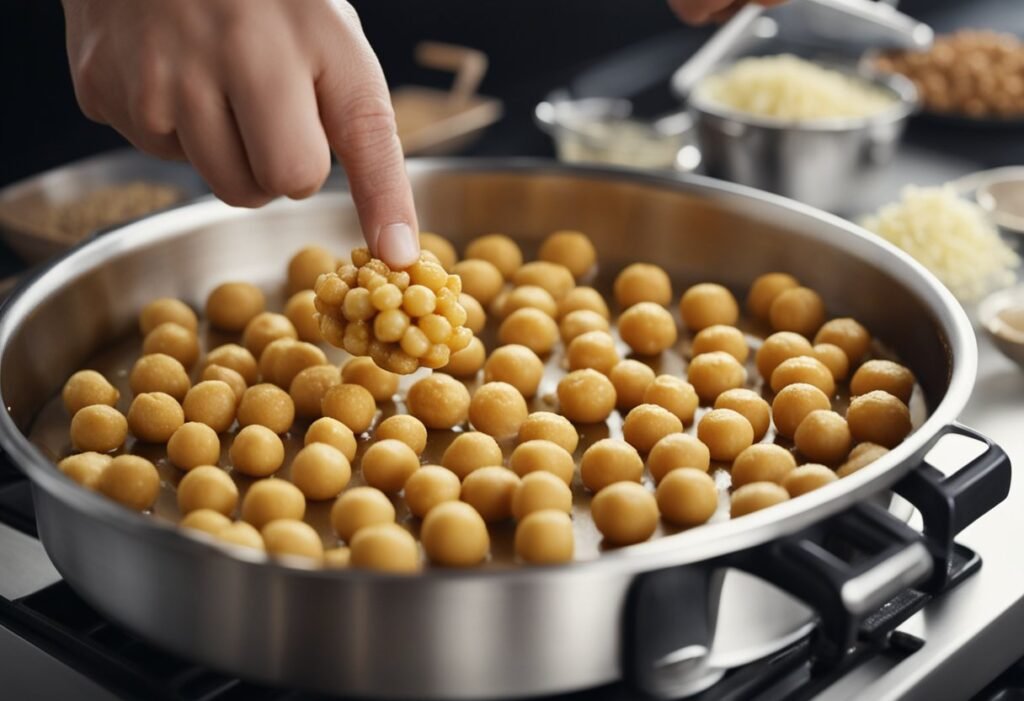
Traditional Methods
When it comes to preparing and cooking falafel, there are various traditional methods that have been passed down through generations. The most common method involves soaking chickpeas overnight and then grinding them with herbs, spices, and other ingredients such as onions and garlic. The resulting mixture is then shaped into small balls or patties and deep-fried until crispy and golden brown.
Another traditional method involves using fava beans instead of chickpeas. This method is popular in Egypt and other parts of the Middle East. The fava beans are soaked overnight, ground with spices and herbs, and then shaped into balls or patties before frying.
Modern Techniques
In recent years, there have been various modern techniques developed for preparing and cooking falafel. One popular method involves using canned chickpeas instead of dried ones, which eliminates the need for soaking and grinding. The chickpeas are simply drained and mashed with the other ingredients before shaping and frying.
Another modern technique involves baking the falafel instead of frying them, which can be a healthier option. To do this, the falafel mixture is shaped into balls or patties and then baked in the oven until crispy and golden brown.
Regardless of the method used, falafel is typically served with a variety of accompaniments such as hummus, tahini sauce, pickles, and fresh vegetables. It can be enjoyed as a snack or as a main course, and is a popular vegetarian and vegan option due to its high protein content and delicious flavor.
Serving and Presentation
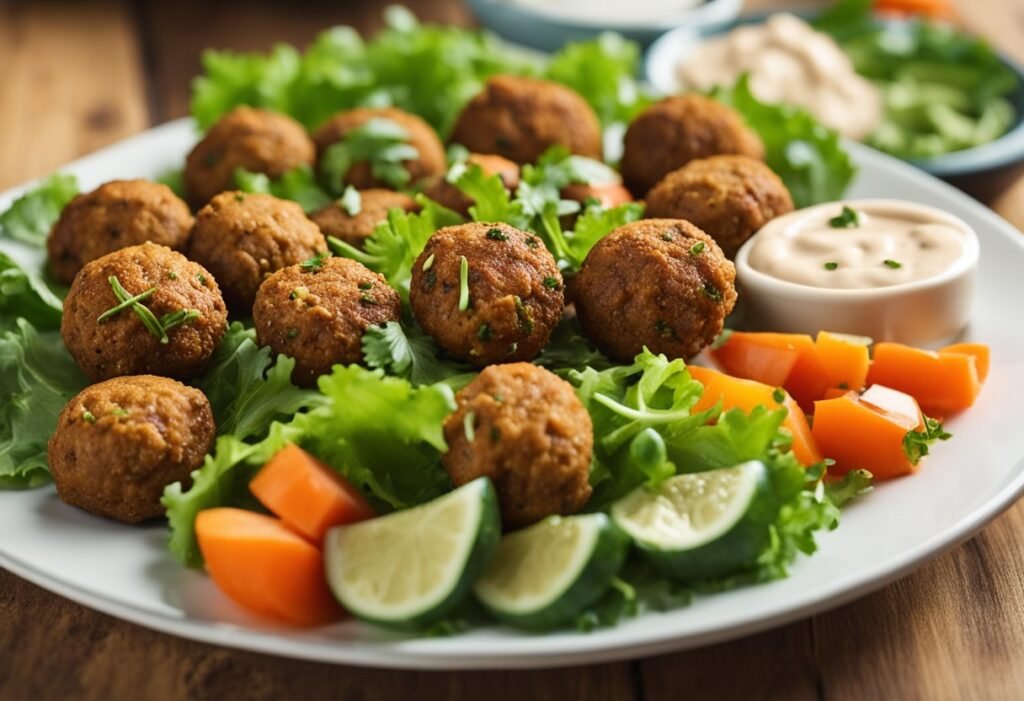
Accompaniments
When it comes to serving falafel, there are a variety of accompaniments that can be used to complement the dish. Some popular options include hummus, tahini sauce, tzatziki, tabbouleh, pickled vegetables, and hot sauce. These accompaniments can either be served alongside the falafel or incorporated into the sandwich or wrap.
Serving Styles
Falafel can be served in a variety of styles, depending on the region and personal preference. In the Middle East, falafel is often served as a sandwich or wrap, with the falafel balls stuffed into a pita bread or wrapped in a flatbread. The sandwich is usually filled with a variety of fresh vegetables, such as lettuce, tomatoes, cucumbers, and onions, as well as the aforementioned accompaniments.
In other parts of the world, falafel is often served as a standalone dish, with the falafel balls served on a plate with the accompaniments on the side. Some restaurants also offer falafel bowls, which are similar to a salad bowl, with the falafel balls served on a bed of lettuce or other greens, and topped with the accompaniments.
Regardless of the serving style, falafel is typically presented in an aesthetically pleasing manner, with the accompaniments arranged neatly around the falafel balls. This not only enhances the visual appeal of the dish but also makes it easier to eat.
Nutritional Information

Health Benefits
Falafel is a nutritious food that provides various health benefits. It is a good source of protein, fiber, and complex carbohydrates. Falafel is also low in fat and cholesterol-free, making it a heart-healthy option. Chickpeas, the main ingredient in falafel, are known to have anti-inflammatory properties and may help lower blood sugar levels. Additionally, falafel contains various vitamins and minerals, such as iron, magnesium, and vitamin B6.
Caloric Content
The caloric content of falafel can vary depending on the recipe and serving size. On average, a single falafel ball contains around 60-70 calories. However, when served in a pita with toppings such as hummus, tahini sauce, and vegetables, the calorie count can increase significantly. It is important to be mindful of portion sizes when consuming falafel to avoid overeating and consuming excess calories.
Overall, falafel can be a healthy and nutritious addition to a balanced diet when consumed in moderation. It is a great option for vegetarians and vegans looking for a plant-based source of protein.
Cultural Significance
In Middle Eastern Cuisine
Falafel is a staple food in Middle Eastern cuisine and is considered a national dish in countries such as Egypt, Lebanon, and Israel. It is commonly served as a street food, in sandwiches, or as a side dish. In these countries, falafel is often made with chickpeas or fava beans, mixed with various spices and herbs, and then deep-fried until crispy.
Falafel has a long history in the Middle East, dating back to ancient Egypt. It was originally made with fava beans, but the use of chickpeas became more common in the 20th century. Today, falafel is enjoyed not only in the Middle East, but also in many other parts of the world.
Global Popularity
Falafel’s popularity has spread beyond the Middle East and is now enjoyed worldwide. It has become a popular vegetarian and vegan food due to its high protein content and flavorful taste. In fact, it is estimated that over 1 billion falafel sandwiches are sold globally each year.
Falafel has also become a symbol of multiculturalism and diversity. It is often seen as a food that brings people together, regardless of their cultural or religious background. In many cities, falafel restaurants are owned and operated by immigrants, making it a symbol of cultural integration and diversity.
Overall, falafel’s cultural significance lies in its ability to bring people together and celebrate diversity. Its popularity both in the Middle East and around the world is a testament to its delicious taste and nutritional value.
Frequently Asked Questions
What are the main ingredients in falafel?
Falafel is typically made with ground chickpeas or fava beans, mixed with herbs and spices such as parsley, cilantro, cumin, and coriander. Other ingredients may include garlic, onion, and flour to bind the mixture together.
Can falafel be considered a healthy food option?
Falafel can be a healthy food option when prepared correctly. It is a great source of plant-based protein, fiber, and nutrients. However, it is important to note that falafel is often deep-fried, which can add extra calories and unhealthy fats. Baking or air-frying falafel can be a healthier alternative.
What is the typical flavor profile of falafel?
Falafel has a savory and earthy flavor with a hint of spice from the herbs and spices used in the mixture. It is often served with tangy and creamy sauces such as tahini or tzatziki, which complement the flavor of the falafel.
Are there gluten-free options for making falafel?
Yes, there are gluten-free options for making falafel. Instead of using flour to bind the mixture together, you can use gluten-free alternatives such as chickpea flour or rice flour.
How does the calorie count of falafel compare to other foods?
The calorie count of falafel can vary depending on how it is prepared and what it is served with. On average, a serving of falafel (about 4 pieces) contains around 300-400 calories. This is similar to other plant-based protein sources such as tofu or lentils.
What are some common ways to serve falafel?
Falafel is often served in a pita bread with lettuce, tomato, cucumber, and a sauce such as tahini or tzatziki. It can also be served on a salad or as a side dish with hummus and other Middle Eastern dips.

